One Innovative Guide’s Secret to Catching Monster Manitoba Pike
Dave Maas 07.20.17
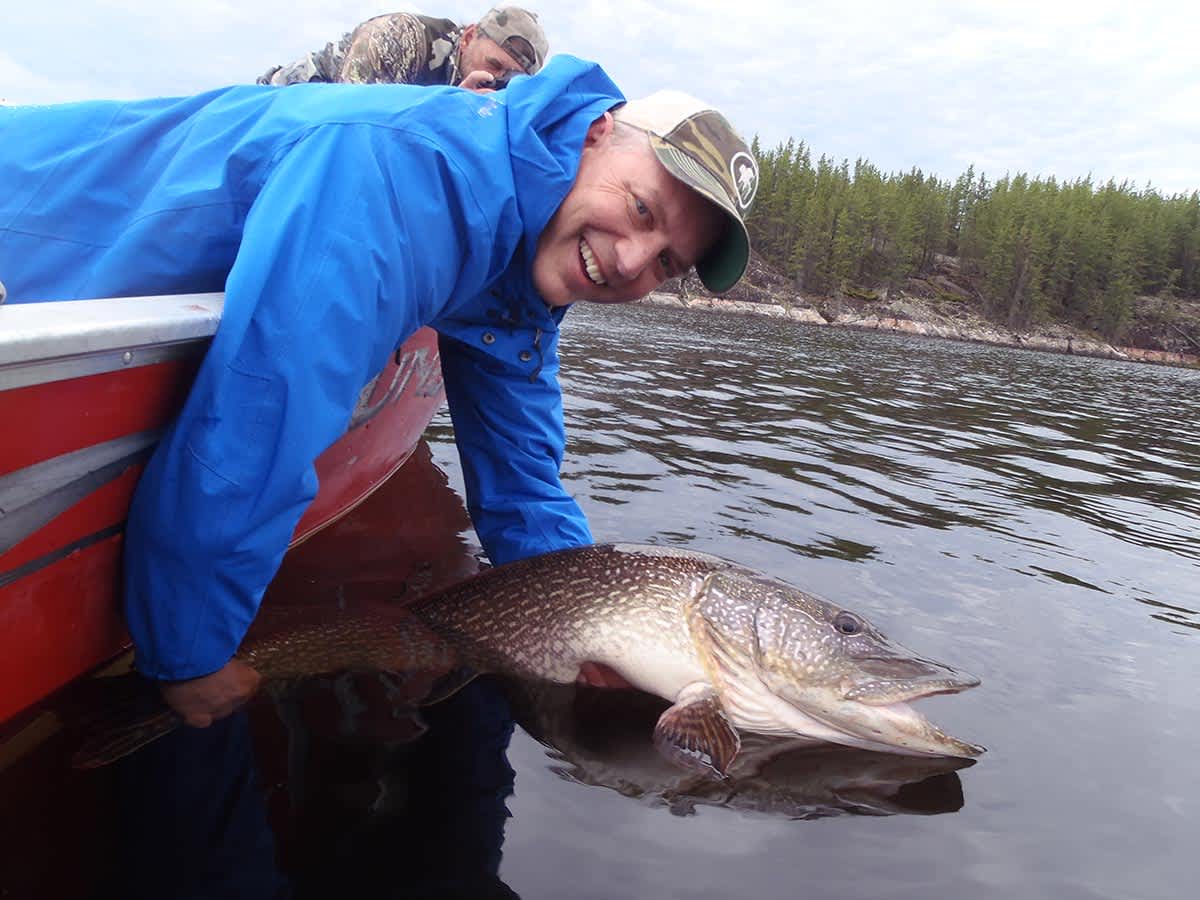
I love to pursue big fish. But “big” is relative to species, and it varies based on region, as well as an individual angler’s experience and opinion. When considering popular gamefish in my home state of Minnesota and neighboring states and provinces, I define a big sunfish as 9 inches or more. Likewise, a list of length minimums (in inches) for other fish in the upper Midwest might look something like this: crappie, 13; smallmouth, 18; largemouth, 20; walleye, 28; northern pike, 36; muskie, 45.
So, how do these minimums change if I modify my description from “big” to “monster,” which is the word used in this article’s title? For me, the lengths increase as follows: monster sunfish, 10; crappie, 15; smallmouth, 20; largemouth, 22; walleye, 30; northern pike, 42; muskie, 50.
Again, these are simply figures that bump around in my fishing mind, so I’m not surprised if your opinion differs. And, fish thickness (i.e. girth) plays a major role, too.
Regardless of your definition of “monster,” however, I think you’ll agree that at least two of the northern pike I caught this spring in Manitoba qualify. And no matter where you fish, I know there’s a good chance that if you employ the specific technique used by the outstanding guide on my Manitoba trip, you’ll hook and land more trophy northern pike than you ever dreamed possible.
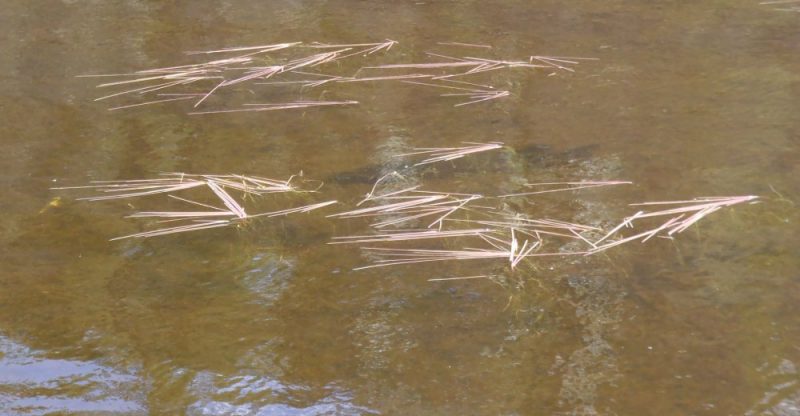
On-the-Fly Innovation
Those of you who have targeted northern pike during early spring know that the fish can be lethargic. And that’s exactly what my brother, Steve, and I found as we began searching the shallows of Aikens Lake with guide Austin Los. Steve and I were two of a dozen guests in camp when Aikens Lake Wilderness Lodge opened for the 2017 season on May 24, and we explained to Austin that while we wanted to catch a few walleyes for shore lunch during our 3 days of fishing, our No. 1 priority was northern pike.
Because pike spawn in back bays while there is often still ice on the main lake, I knew that spawning would be completed by the time we hit the water in late May. That said, the water temp in these back bays would still be cold enough to keep pike from leaving the bays and heading toward their ultimate destination for summer and fall, which would include main lake points, humps and shorelines. While small- to medium-sized pike behave much like largemouth bass and will stay relatively shallow (say 15 feet or less) from spring through fall, those pike measuring approximately 36 inches or more typically head for deeper and cooler portions of any lake.
I mention these facts about pike preferences to explain why I fully expected to find post-spawn northern pike on Aikens Lake, and as any avid angler knows, the post-spawn period can be a challenge when targeting any specific species. As for Aikens Lake pike, identifying the bays holding trophy pike wouldn’t be the biggest problem, the trick would be triggering them to strike.
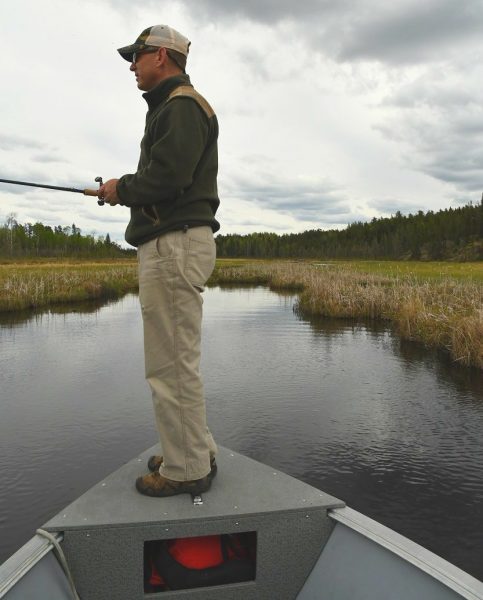
Esox Spot-and-Stalk
After taking a quick look at the Aikens Lake map with Austin, we decided to start our search in several large, dark-bottomed bays extending off the northwestern side of the lake. Steve and I immediately began catching small pike on spinnerbaits and spoons. And as the hours ticked by, we both had boated more than 20 pike. Thus far, however, our biggest fish had been 5 pounds, so the search for an Aikens Lake trophy continued.
“There’s a big fish!” I yelled from the bow of the boat. As we drifted into the back of Moosehead Bay, I spotted a 38- to 40-inch pike sunning itself on the bottom. The fish turned on my spoon and took a half-hearted swipe at it, missing the lure entirely. We continued to cast — Steve with a spinnerbait and me with a spoon — but we couldn’t trigger another follow or strike from the big pike.
“Time to rig a ciscoe,” Austin said in a matter-of-fact tone from the back of the boat. “Many times, these early season pike won’t strike a lure, but they can’t resist meat.”
In between casts, I watched Austin rig an 8-inch dead ciscoe. He used a DIY quick-strike system of his own design; the rig included a single hook combined with a treble. He set the bobber to 4 feet; the actual depth in this portion of the bay was 5-6 feet. Austin made a short cast behind the boat with the ciscoe rig as Steve and I continued to pepper the shoreline with casts.
“Bobber’s down!” Austin yelled not 5 minutes later.
“Dave, you take it,” my brother graciously offered.
We watched the submerged bobber in the clear water for a minute as Austin explained our next move. “Dave, I like to minimize the amount of line out for the hook set,” he said, “so I’ll sneak over toward the fish with the trolling motor. Sometimes with small pike, the bobber will resurface from time to time, but this fish is keeping it down and just slowing moving away. Chances are it’s a good fish.”
Soon, Austin had maneuvered the boat within 30 feet of the bobber. “Whenever you’re ready, Dave,” he instructed. “Just give the rod a decent sweep-set and then keep pressure on the fish. The quick-strike hooks are super sharp, so you don’t have to go crazy with the hook set.”
A minute later, Austin was netting a 37-inch Aikens Lake pike, and Steve and I were believers in our guide’s dead-bait system for spring pike.
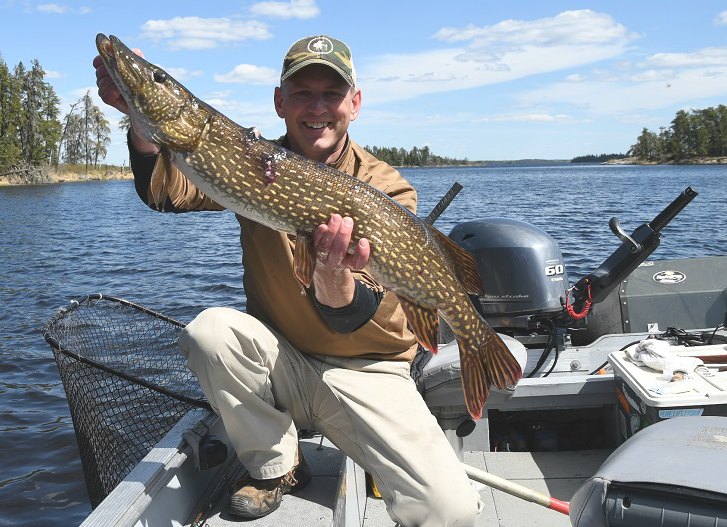
Only minutes after I caught the 37-incher, Steve had a 41-inch pike smash his spinnerbait at boatside. Manitoba has a very popular Master Angler Awards Program, and Steve’s fish qualified by meeting the minimum-length requirement for pike: 41 inches.
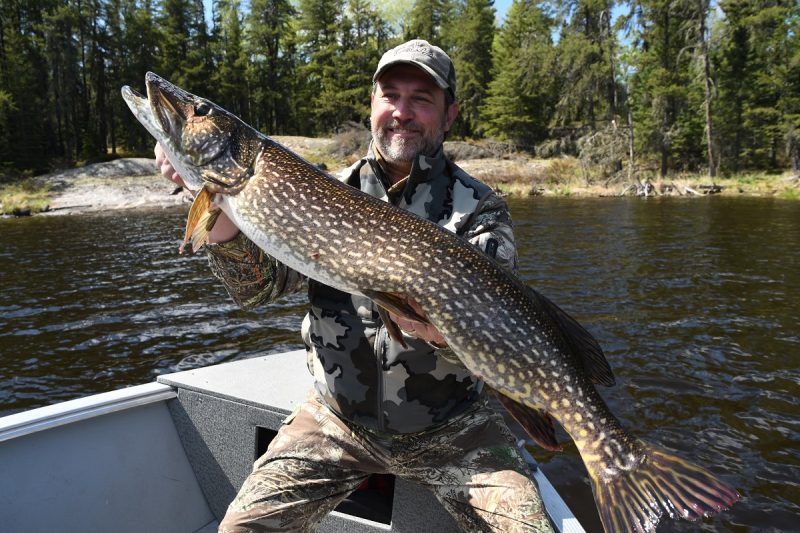
From Bobbers to . . . Planer Boards?
After stopping to catch a few walleyes (at Aikens, it’s often like making a quick stop at the local grocery store), Austin prepared a fantastic shore lunch (below). Soon, we were back on the pike pursuit. We caught many more small pike, which are often called snakes or hammer handles, but didn’t spot or catch any trophies. In many ways, spot-and-stalk for big pike isn’t too different than hunting big game. The action isn’t constant, but when it happens, the work is worth the effort.
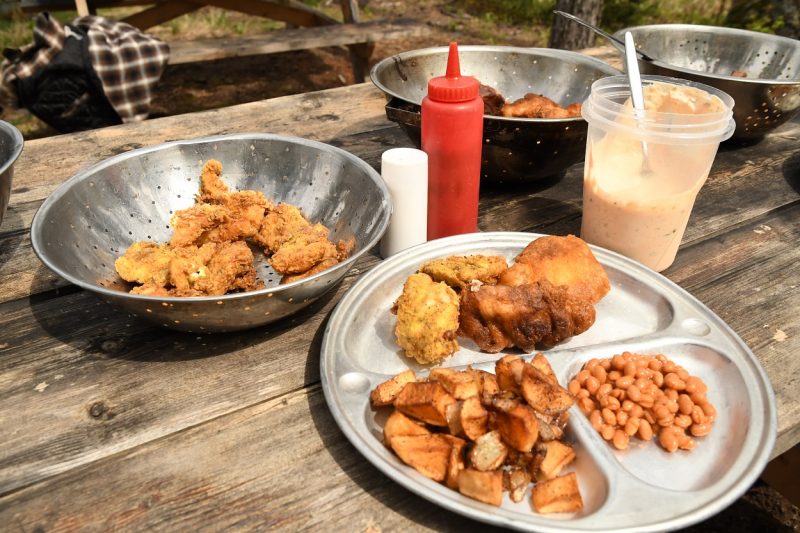
The weather on day No. 2 was much like our first day (sunny and warm), and while we continued to visit numerous shallow-water bays on the north and northwest parts of Aikens, we didn’t hook or land any big pike. We spotted a few fish in the 36- to 38-inch range, but they wouldn’t strike lures, and the only pike that seemed interested in the dead cisco offering were fish weighing 7 pounds or less. Like I said, searching for trophy pike is like big game hunting.
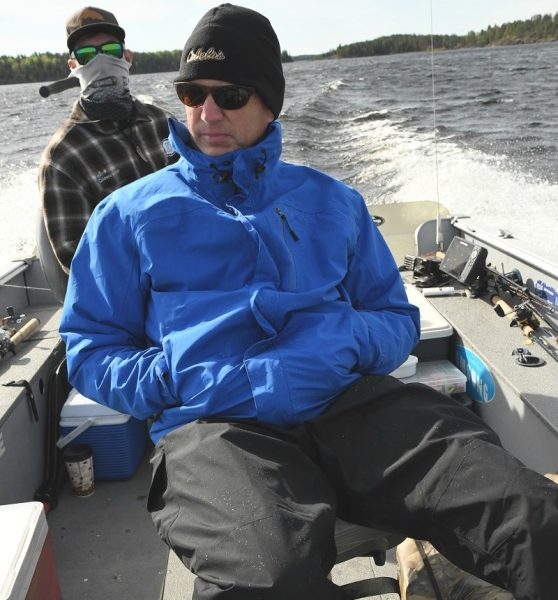
“Austin, I have an idea,” I said as we stepped into his guide boat to begin day No. 3. “Seems like all the other guides have been taking their guests to the northwest side of the lake, and especially Moosehead Bay where we caught the 37- and 41-incher our first day. Do you think it’d be worth exploring some of the bays on the opposite side of the lake?”
“Sounds good,” Austin said. “Many of those bays contain deeper water than those to the northwest, so they probably won’t be as warm. But those bays haven’t been fished since last season, so it’s worth a shot.”
Austin was right. Instead of finding water temps of 58-60 degrees, like we marked in the best bays to the northwest, the southern bays contained water of 54-56 degrees. That might not sound like a big difference, but during spring, the mood of post-spawn pike can swing widely based on a few degrees. Not only were the big pike seemingly absent, but the number of smaller pike were lacking, too. Maybe my idea of heading south wasn’t looking like such a good plan after all.
That is, until Austin slipped the boat into Secret Bay.
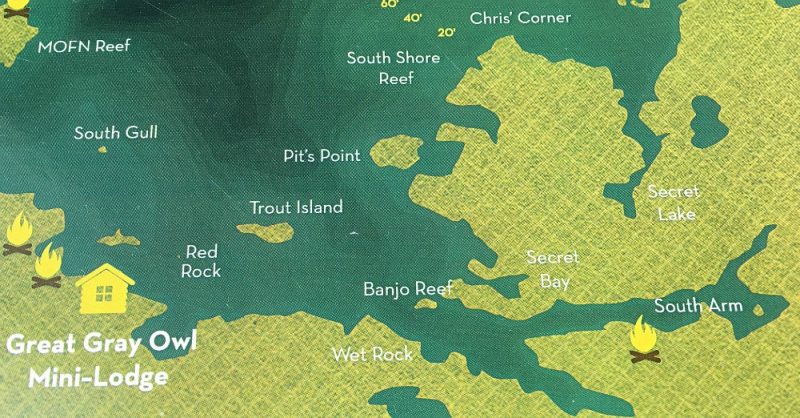
Austin and I immediately looked at each other as we passed through a line of massive underwater boulders that effectively separated the bay from the main lake — the temp on the Humminbird registered 58 degrees, and we had just entered the mouth of Secret Bay. I hoped that the water in the back regions of the bay might hit the magic 60-degree mark. I say “magic,” because that’s what the fishfinder indicated the moment we’d landed our 37- and 41-inchers on day No. 1 in Moosehead Bay.
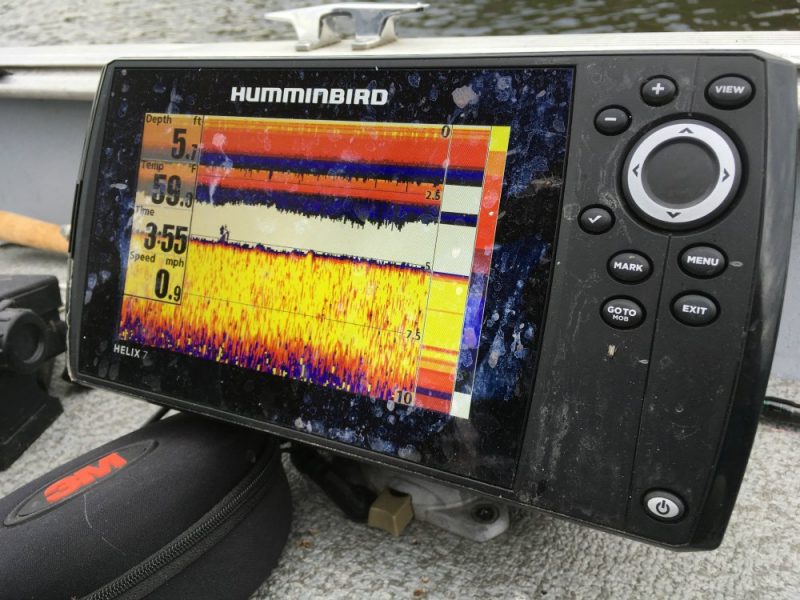
“There’s a big pike,” I said as we slowly inched along the shore. The fish looked way bigger than I cared to admit to Austin, and try as I might, I couldn’t get the fish to strike. I even placed an 8-inch soft-plastic minnow imitation in front of the pike’s nose, but she ignored it. Finally, she drifted away from the bow of the boat and disappeared toward the middle of the bay.
Austin, of course, continued to trail a dead ciscoe behind the boat, and 5 minutes later we all heard Austin’s rod clank against the side of the boat. “Bobber’s gone,” Steve said. “That’s a good sign!”
Like we’d done several times before during the 3 days, Austin crept closer to the submerged bobber with aid of the trolling motor. It was my turn on the ciscoe rod, and I hoped it was a decent-sized pike.
On the hook set, this fish felt heavier than the 37-incher I’d caught on the first day. And as the pike pulled off drag and raced from the bow of the boat around the stern, I could tell it was stronger, too. But none of us were prepared for the moment we spotted the pike for the first time.
“It’s barely hooked in the corner of the mouth with only one hook,” Austin instructed in a serious tone. “This pike is really big; I want to net her as quickly as we can.”
A few seconds later, I guided the pike’s huge head into the net, and we all stared in disbelief at the monster fish. Typical of a post-spawn pike, she wasn’t thick, but at an amazing 47 inches — even with a ragged tail from spawning — she probably weighed close to 25 pounds.

“This is the longest pike taken at Aikens in the last 5 years,” Austin stated as he stretched a tape to the fish’s tail. Look at my hand . . . I’m shaking!”
After a quick photo session, I held the pike at boat side and gently rocked her tail from side to side, still in shock at the pike’s length. She didn’t seem real . . . but there she was in my hands. Thirty seconds later, she began to grow annoyed of my tail hold, and sensing that she was ready to go, I opened my hand so she could swim away.
We reveled in our success during a stop back at the lodge for a quick lunch, then headed back to Secret Bay to see if any other monster pike were willing to bite. And this is when our afternoon really got interesting.
As I continued to throw a soft-plastic swimbait off the bow of the boat, my brother sat in the middle seat to take a quick break from casting his spinnerbait.
“Steve, I’ve got an idea,” Austin said. “The big fish seem to want ciscoes more than artificials, so I could rig up a second dead-bait rod. It might double our chances.”

My brother liked the idea, and soon Austin was rigging up ciscoe rod No. 2. But rather than suspending the second dead bait below a bobber, which would mean both rigs would be bumping into each other behind the boat, Austin had a better idea.
“You know what?” he said, with one of those light-bulb-moment looks on his face. “I’m going to rig this one behind a planer board. That way, the bobber will cover fish behind the boat, and the board will cover fish out to one side. I tried it once last year, and we caught a small pike off the board, so I think it’s worth a shot.”

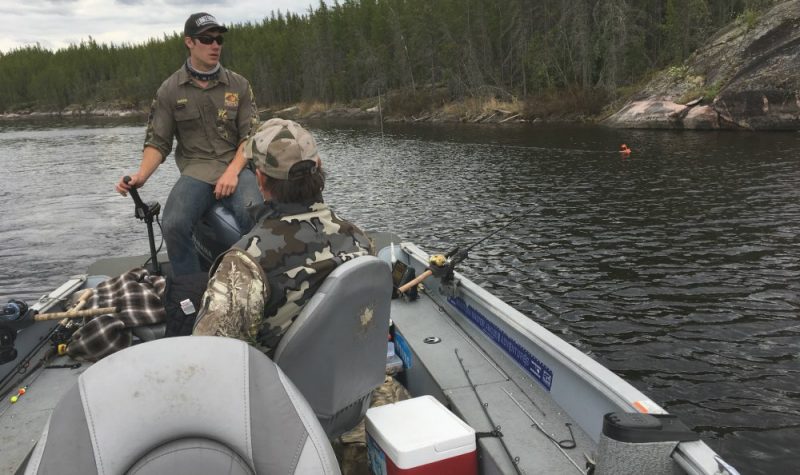
Like before, with me standing in the bow casting along the shore, Austin slowly guided our boat along Secret Bay’s shoreline. But now, with two ciscoe rigs to watch, it was kind of like tip-up fishing for pike during the ice fishing season. My eyes constantly danced from watching behind my lure, to glancing for action on either the bobber or planer board.
“There’s a decent fish,” I said, spotting a 40-inch-class pike. It had ignored my lure and swam under the bow of the boat. “It’s heading toward the planer board.”
And unbelievably, a minute later the large planer board disappeared like a tiny crappie bobber. Even the board’s flag was nowhere to be seen.
“It’s like a scene from Jaws,” my brother said. “I can’t believe a pike can keep that board under the water.”
The three of us stood in the boat like explorers searching for the New World. Where was the board?
Finally, after nearly a minute, it surfaced, and Austin guided the boat toward the ciscoe rig. “I want to make sure we’re on the same side of the board as the fish before we set the hook,” Austin warned.
For the next few minutes, the pike and our boat played an on-the-water dance. We’d circle the board clockwise, attempting to get around to the line-side of the board, and as we moved, the pike, which we couldn’t see yet, would turn the board away from us. It was almost as if the fish knew our game plan.
“There we go,” Austin stated. The pike had finally stopped turning the board. “Steve, set the hook whenever you’re ready.”
Steve could immediately tell it was a heavy fish, and soon Austin was removing the planer board from the line and Steve finished the battle. It was Steve’s second Manitoba Master Angler pike, a 41-incher that looked like a twin to the fish he landed on day No. 1.
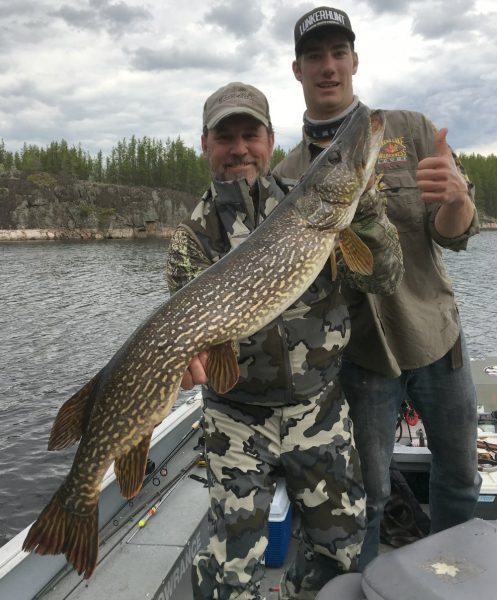
Lightning Strikes Twice in the Same Boat
I’m sure Steve’s planer board pike was the same one I’d seen cruising below the bow of the boat, so I continued to “run point” and look for pike while casting. It was a good system — me spotting and Austin make slight steering adjustments to ensure our dead baits were hovering over lethargic pike.
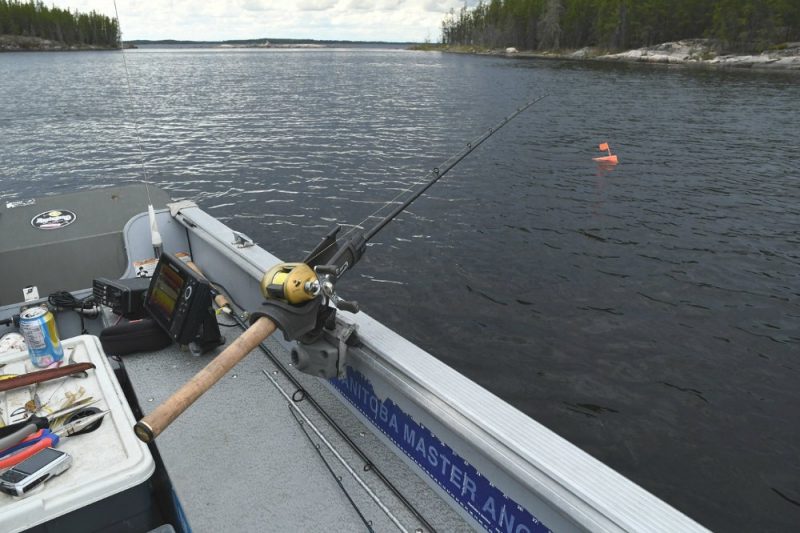
“I’m pretty sure I spotted a good fish to the right,” I said to Austin. “I didn’t get a great look at it, but hopefully it’ll see one of our ciscoes.”
And just like before, the three of us anglers stood in amazement as the planer board disappeared beneath the surface of Secret Bay. “It’s kind of like tip-up fishing in reverse,” Steve said with a smile. “Instead of waiting for a flag to fly, we wait for the flag on the board to disappear.”
It was my turn on the rod, and as I set the hook, I could tell this fish, like my 47-incher from a couple hours earlier, was something special.
As we all stared into the water hoping to catch a first glimpse of the fighting fish, it finally surfaced and took a run toward the boat, with much of its back out of the water.
“Oh my God, it’s a whale!” is what I remember yelling to my boat partners. And after Austin sled the net around the monster pike, he exclaimed: “I think she’s a bit shorter than your 47, but she’s as fat as a fall fish. What an amazing pike!”
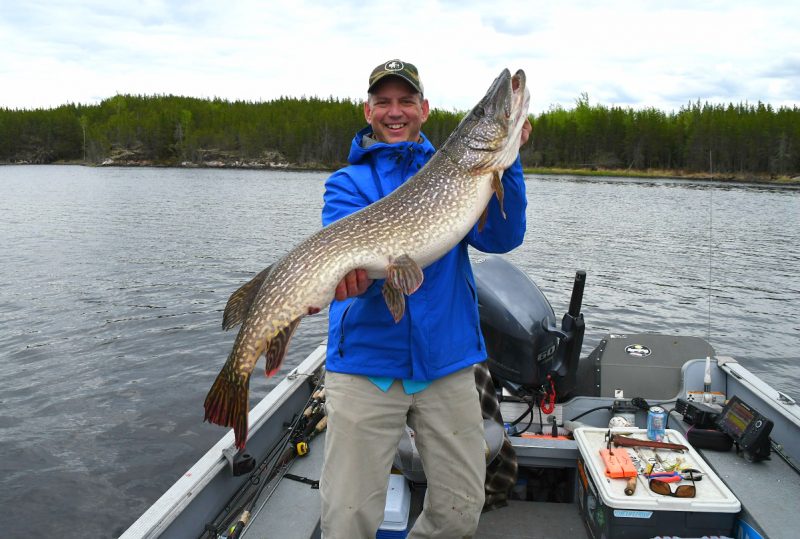
The tape revealed she was 45 inches in length, and while we didn’t take a girth measurement, I have to believe she weighed as much as, if not a pound or two more, than my 47-incher.
The Aikens Experience
Of course, not every guest visiting Aikens can expect to catch a 45- and 47-inch northern pike. I was blessed beyond measure.
It is a fact, however, that most of the dozen anglers in camp during late May who focused on pike had a 41-inch Master Angler fish on the line. My brother landed two.
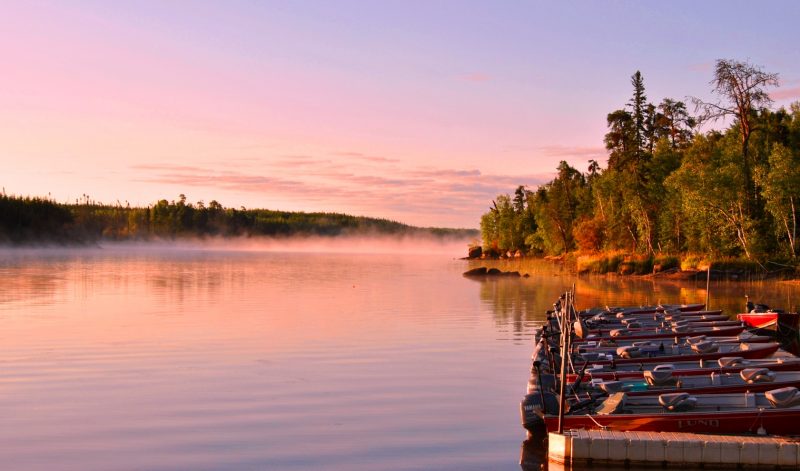
Whether you target pike, walleyes or lake trout, one thing is guaranteed: You’ll have the time of your life at Aikens. (Click here to read my recent OHUB article, “Top 10 Reasons to Visit Aikens Lake Wilderness Lodge.”) Everything from the staff and equipment to the food and accommodations is top-notch. Period.
One final note: If Aikens Lake doesn’t fit into your travel plans, be sure to check out the many other fine destinations in Manitoba. The province has a lot to offer. I’m taking my kids and father to Manitoba in late August 2017 to pursue monster channel catfish in the Red River near Winnipeg. I can’t wait!

